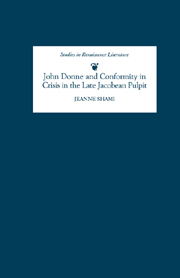Book contents
- Frontmatter
- Contents
- Dedication
- Acknowledgements
- Abbreviations
- 1 “Discreet or religious preachers”: John Donne and the late Jacobean Public Sphere
- 2 “The indiscretion of that foole”: John Knight and the Jacobean Pulpit, 1620–2
- 3 “The fishing of whales”: John Donne's Sermons, 1620–2
- 4 “Faire interpretation”: The Directions and the Crisis of Censorship
- 5 “Wise as Serpents, and innocent as Doves”: Zeal and Discretion in the Pulpit, 1623–5
- 6 “Jesus Wept”: The Journey to Spain and Pulpit Lamentation
- 7 “Blinde buzzards in the choise of a wife”: Sermons and the Moral Marketplace
- 8 “The Lovesick Spouse”: Parliament, Patriots, and the Public Sphere
- 9 “Church-quakes”: Post-Parliamentary Faultlines
- 10 “If the Foundations be Destroyed”: Rules of Engagement
- 11 “Blessed sobriety”: John Donne, the Public Sphere, and Caroline Conformity
- Works Cited
- General Index
- Index to John Donne References
- Index to John Donne's Sermons
- Studies in Renaissance Literature
1 - “Discreet or religious preachers”: John Donne and the late Jacobean Public Sphere
Published online by Cambridge University Press: 12 September 2012
- Frontmatter
- Contents
- Dedication
- Acknowledgements
- Abbreviations
- 1 “Discreet or religious preachers”: John Donne and the late Jacobean Public Sphere
- 2 “The indiscretion of that foole”: John Knight and the Jacobean Pulpit, 1620–2
- 3 “The fishing of whales”: John Donne's Sermons, 1620–2
- 4 “Faire interpretation”: The Directions and the Crisis of Censorship
- 5 “Wise as Serpents, and innocent as Doves”: Zeal and Discretion in the Pulpit, 1623–5
- 6 “Jesus Wept”: The Journey to Spain and Pulpit Lamentation
- 7 “Blinde buzzards in the choise of a wife”: Sermons and the Moral Marketplace
- 8 “The Lovesick Spouse”: Parliament, Patriots, and the Public Sphere
- 9 “Church-quakes”: Post-Parliamentary Faultlines
- 10 “If the Foundations be Destroyed”: Rules of Engagement
- 11 “Blessed sobriety”: John Donne, the Public Sphere, and Caroline Conformity
- Works Cited
- General Index
- Index to John Donne References
- Index to John Donne's Sermons
- Studies in Renaissance Literature
Summary
MOMENT OF CRISIS
THIS STUDY proposes to examine the late Jacobean pulpit, and particularly the sermons of John Donne, as an index of “conformity” and its expression in the years immediately preceding and including the transition from the Jacobean to the Caroline monarchy (1621–5). During these years, sermons, always important in Jacobean religious and political culture, became sites of contention for important matters of religious and national identity, contention epitomized by James I's Directions to Preachers. These Directions, issued on 4 August 1622 by George Abbot, Archbishop of Canterbury, were an attempt to reduce to order a pulpit that had become increasingly critical of and outspoken about the implications for religious belief and practice of James's domestic and foreign policies. The uncertainty created by James's inconsistent policies regarding Catholics, his negotiations for a Spanish marriage for his son Charles, and his apparent indifference to the affairs of his daughter Elizabeth, her husband the Elector Palatine (now claiming the title of King of Bohemia), and James's grandchildren on the continent contributed to the heightened religious tension. Even the decision to issue such directions attested to James's desperation, or perhaps to his waning political acuity. Such an edict was practically unenforceable, especially outside London, and subject to the energy, commitment, and political agenda of James's bishops and their agents. Whether or not the Directions were actually effective in controlling the kinds of pulpit discourse that James intended, however, their issuing exposed fault lines in the Church of England that contributed to a reconfigured Caroline church and the demise of the Jacobean order.
- Type
- Chapter
- Information
- Publisher: Boydell & BrewerPrint publication year: 2003

